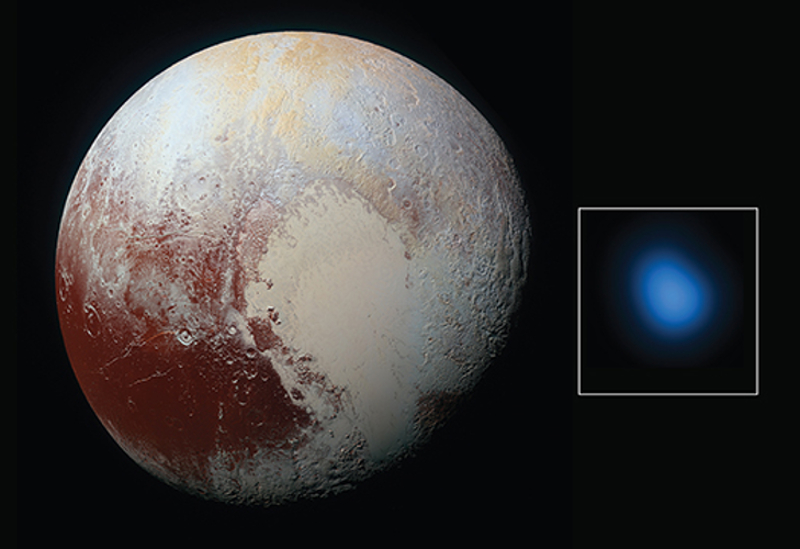
 Credit: X-ray: NASA/CXC/JHUAPL/R.McNutt et al; Optical: NASA/JHUAPL
Credit: X-ray: NASA/CXC/JHUAPL/R.McNutt et al; Optical: NASA/JHUAPL
Exchange at Pluto
A little over a year ago, the New Horizons spacecraft provided our first close-up views of the dwarf planet Pluto, revealing a surprisingly active frozen world - glaciers made of solid nitrogen, floating mountains of water ice, a 13,000 foot high mountain which may be a volcano spewing ice, not fire, a moon sporting a strange red spot made of organic material, and, most notably, Tombaugh Regio, a large, heart-shaped plain of frozen mixture of nitrogen, carbon monoxide and methane. New Horizons is now speeding to a January 1, 2019 rendezvous with a distant object in the Kuiper Belt, a cloud of comets and minor planets which surrounds the solar system. But Pluto keeps surprising. A new observation with the Chandra X-ray Observatory of Pluto has, for the first time, detected energetic X-ray radiation from this frozen world. The image above shows, on the left, a beautiful image of Pluto taken during the New Horizon flyby (prominently showing Tombaugh Regio) and the X-ray image from Chandra on the right. (Because Chandra is in earth's orbit, far from Pluto, Chandra cannot provide detailed images of features in Pluto's X-ray emission.) It may sound surprising that such a cold object could emit X-rays, which are often associated with hot gas at temperatures of millions of degrees. But astronomers have known for decades that cold objects like comets could produce X-radiation. These X-rays are produced by the interaction between energetic particles in the solar wind and cold atoms in the atmosphere surrounding the comet or planet. These X-rays are produced in a process called "charge exchange". During collisions between the solar wind and Pluto's thin atmosphere, electrons can be exchanged between the atmospheric atoms and ions in the solar wind; as these electrons cascade to lower energy states, X-ray photons can be emitted. The X-ray brightness of Pluto is surprising astronomers, however, given how weak the solar wind should be at Pluto's distance. Lots of Plutonian mysteries still to be unraveled.
Published: September 19, 2016
<
HEA Dictionary ● Archive
● Search HEAPOW
● Other Languages
● HEAPOW on Facebook
● Download all Images
● Education ● HEAD
>

Each week the HEASARC
brings you new, exciting and beautiful images from X-ray and Gamma ray
astronomy. Check back each week and be sure to check out the HEAPOW archive!
Page Author: Dr. Michael F. Corcoran
Last modified Tuesday, 27-Feb-2024 10:08:21 EST


